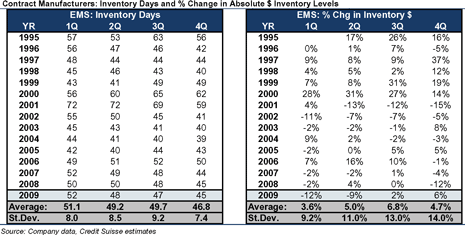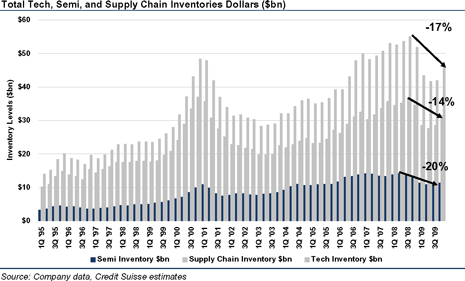38.8 days average inventory. EMS inventory value up 6%, inventory days down 2. Value of semiconductor inventory up 6.6%. Component distributors inventory value up 8%. Despite 4Q09 modest restocking, total tech inventories down 17% from peak levels, semi down 20%, supply chain down 14%. Inventory burden could shift downstream due to improving supply factors driving scarcity value in chips.
Depending on where you are in the supply chain, a lean inventory channel or an ample supply can spell either success or failure if all players are not tuned in to one another.
According to one research report circulating from Wall Street, the first 25% of the fourth quarter in 2009 (4Q09) saw the dollars (value) of total electronics supply chain inventories up 9.3%, 470 basis points (bps) above seasonal growth of +4.5%.
Days inventory were up 0.2 days versus seasonal declines of 3.3 days to 44.5 days, still 6.8 days below the 2008 average of 51.3 days, and just 0.2 days above the 3Q09 historical low point of the history by investment bank Credit Suisse, which released the report and has been tracking the data since 1995. Looking more closely, variation in tech inventories does exist when looking at certain electronics market segments. Some highs and lows follow.
Overall electronics inventory: The overall electronics supply chain (total tech excluding semiconductors and components) was above seasonal and grew inventory dollars (i.e., value) by 11.0% quarter-on-quarter (q/q) versus seasonal growth of +5.9% q/q, while inventory days were up 0.2 days to 38.8 days, versus the normal -3.8 day decline.
Semiconductors inventory: The semiconductor inventory segment of the supply chain grew dollar value 6.6% q/q versus seasonal +1.0% q/q, while days increased by 2.5 days, vs. the normal -1.3 day decline. Take away: Semiconductor inventory days and inventory dollars (value) are both above seasonal figures. (Greater semiconductor detail in article section titled, ‘Semiconductor inventories highlights, sub-segments’)
Components inventory: The components inventory segment of the supply chain grew 2% q/q, 290bps better than seasonal of 4.6% q/q on a days basis. Components declined 2 days versus the seasonal 3.3 day increase. Take away: Components inventory days and inventory dollars (value) are both below seasonal figures.
EMS inventory: Electronics manufacturing services (EMS) inventory came in roughly in-line with seasonal figures. EMS inventory dollars grew 6% q/q, 1.1% above the seasonal pattern of +4.7% q/q on a days basis. Days of inventory were down by 2 days versus seasonal declines of -2.9 days. Take away: EMS inventory days and dollars are both roughly in-line with seasonal figures. (See Figure 1, Figure 2)
Figure 1: Inventory days by sub-segments (note EMS)

Figure 2: Contract manufacturers: Inventory days and % change in absolute $ inventory levels

Component distributor inventory: Component distributors saw inventory dollars grow 8% q/q above the seasonal +3.5%, while days inventory fell by 1 day, versus seasonal -2.4 days. Take away: Component distributor inventory days and dollars are both above seasonal.
System distributor inventory: System distributors saw inventory dollars grow +51% q/q, above normal seasonal +46% growth, while days inventory grew 21 days q/q above the normal +15.2 day increase. Take away: System distributor inventory days and dollars are both above seasonal.Communications OEM inventory: Communications OEMs saw inventory dollars decline 10% q/q, versus seasonal -1.1% q/q, while days fell -5 days q/q versus the seasonal -9.1 day change q/q. Take away: Communications inventory dollars better than seasonal, days worse than seasonal.
Computing OEMs inventory: Computing OEMs saw inventory grow +10% q/q, versus seasonal -4.4% q/q, while days fell by -2, versus the normal -6 day decline. Take away: Computing OEM inventory dollars better than seasonal, days better than seasonal.
Looking ahead
On a forward looking basis, assuming semiconductor production remains flat sequentially, Credit Suisse estimates semiconductor inventory dollars will grow 8.0% q/q in C1Q10; above the seasonal 3.0% q/q growth, driving inventory days up 4.9 days q/q, versus the seasonal 3.9 day increase.
The report goes further to estimate supply chain inventories will be up 3.0%, versus the normal 3% decline, with days up 2.8 versus the normal 0.6 day growth, and total tech inventories up 4.2%, versus seasonal declines of 1.6%, and days up 3.5 q/q versus 1Q seasonal growth of 1.3 days.
The bank’s report brings attention to long-term trends (2005-2008 average), days for semis, supply chain, and tech days would still be below trend.
Semiconductor inventories highlights, sub-segments
From a semiconductor perspective, 37 of the 52 companies Credit Suisse tracks reported C4Q results, representing roughly 90% of total semiconductor inventory dollars. Total semiconductor inventory dollars grew 6.6% q/q, versus the normal seasonal 1.0% q/q growth.
Semiconductor inventory days grew 2.5 days q/q versus seasonal declines of 1.3 days. At the time of publishing this article, Credit Suisse estimates semiconductor inventory days are now at 65, 10.3 days below the 2008 average of 75.4, at levels not seen since 4Q05, and prior to that, since 2003.
Semi analog / diversified inventory: Analog / diversified inventory dollars grew 2% q/q, in-line with seasonal growth of 0.8%, while days were flat q/q versus the normal seasonal 0.2 day increase q/q. Days at 74 are 26 days lower than the 4Q08 peak of 100 days. Take away: Semi analog / diversified dollars and days seem to be in-line with seasonal expectations.
Semi communications IC inventory: Communications IC inventory dollars were flat q/q, versus the normal 3.8% growth, while days declined 0.7 days q/q versus the normal 1.2 day decline. Take away: Communications IC dollars better, days in-line with seasonal.
Semi MPU (microprocessor unit) inventory: MPU semi inventory dollars grew 17% q/q versus seasonal declines of -0.7%, while days grew 12 q/q compared to seasonality of -3 days. Credit Suisse estimates much of the MPU inventory growth was driven by Intel’s 32nm ramp which drive its inventories +18% q/q; on a units basis, Intel’s inventories were actually flat q/q. Take away: MPU inventories above seasonal for both dollars and days.
Foundry inventory: Foundry inventory dollars were up 8% q/q above the historical seasonality of +2%. Days of inventory grew by 2 versus seasonal -1.8 q/q. Take away: Foundry inventory dollars and days both above seasonal.
Semi memory inventory: Memory saw inventory dollars grew 2% q/q, below seasonal +10.7% q/q, and days declined 13 q/q, versus the normal seasonal +2 day change. Take away: Memory inventory is better than seasonal for both dollars and days
Semi PLD (programmable logic device) inventory: PLD inventory dollars grew 16% q/q, versus the seasonal +4% q/q, while days declined 1 days q/q, better than the seasonal +1.3 day increase. Take away: PLD inventory above seasonal for dollars, below seasonal for days inventory.
Inventories still below trend
Despite modest restocking in 4Q09, the Credit Suisse report emphasizes that total tech inventories are still 17% down from peak levels, semi inventories still 20% below, and supply chain 14% below.
The bank further notes that semi inventory dollars would need to grow 25% before re-testing prior 2Q08 peaks…and, to retest 2008 average days levels, semiconductor inventories would need to grow 16%.
Similarly, the supply chain would need to grow 11% to return to peak dollars levels, and grow13% to return to 2008 average days levels. (Figure 3, below)
Figure 3: Total tech, semiconductor, supply chain inventories dollars

Inventory shift downstream could drive upside
Longer-term, Credit Suisse argues in its report the next upturn in semis has the potential to be significantly stronger than expected – based upon the firm’s view that sustainability higher utilization levels (driven by slowing supply growth post the 300 mm transition) will force the inventory burden downstream… if even modestly.
Over the last 8 years, the bank notes that semiconductors have been forced to carry a significantly higher inventory burden. The firm’s current sub-set of tech inventories shows that in the late 90’s semis represented approximately 18% to 19% of total tech inventory – this percentage peaked in 2005 just over 30%, averaged 25.9% in 2008 and currently stands at 24.7% (down 60bps q/q).
The report states further that semis’ increased inventory burden was a result of the structural overcapacity post the tech bubble (average utilization excluding memory since 2001 has been below 80%) caused firstly by the absolute dollars of capex spent during the bubble and secondly by the transition to 300 mm – no one was worried about availability, there was no scarcity value to chips.
In this downturn, capex spending in 2009 was estimated to be $22.2 billion (9.9% of revenues), down 63% from its peak of $59 billion in 2007 and 50% below the 20.4% trend line post the tech bubble (from 2002 to 2008). Even with a projected 58% increase in capex spending in 2010, capex will only account for 13.0% of semi revenues, 36% below the same trend line.
Excluding the highly cyclical (and commodity) memory capex, 2009 and 2010 capex is expected to be 7.6% and 8.3% of revenues respectively, also well below the 2002 to 2008 15.2% trend line.
The bank’s report further notes that even with the up-tick in 2010 capex spending, excluding memory capex in 2009 and 2010 will be the two lowest capex spending years this decade. The firm also expects improving supply factors to drive scarcity value in chips, and the potential for the inventory burden to shift downstream.
Source: Credit Suisse, VentureOutsource.com, February 2010
Get list of EMS manufacturers for your requirements (Its free)
Save time and money. Find quality EMS manufacturers. Fast. Venture Outsource has a massive, global database of contract electronic design and manufacturing capabilities. Speak with a Provider Advisor.
“Was able to very quickly find details on the important elements of setting up EMS and ODM partnerships, talked with an advisor for personalized info on quality providers matching our requirements while getting up to speed quickly about the industry and connect with key staff from like-minded companies and potential partners. Great resource.”
— Jeff Treuhaft, Sr. Vice President, Fusion-IO
Advisors tell you matches we find for your needs, answer your questions and, can share EMS industry knowledge specific to your industries and markets.









